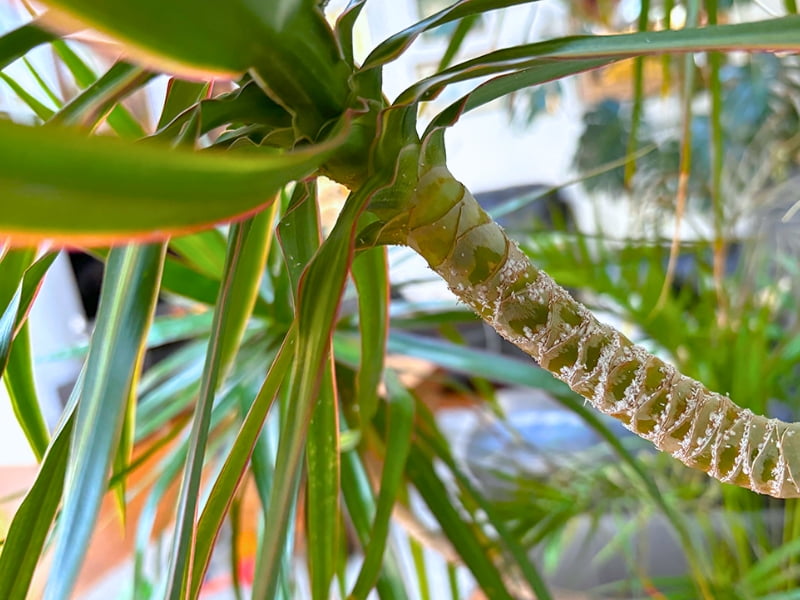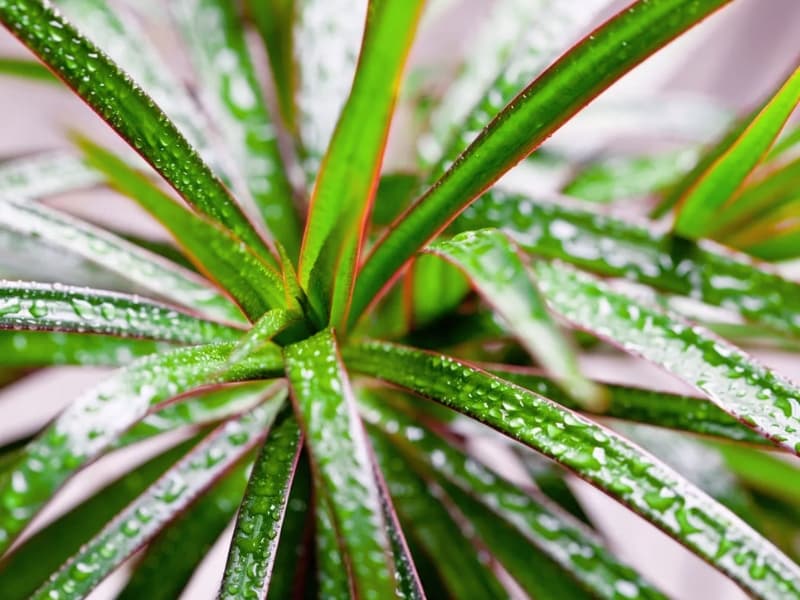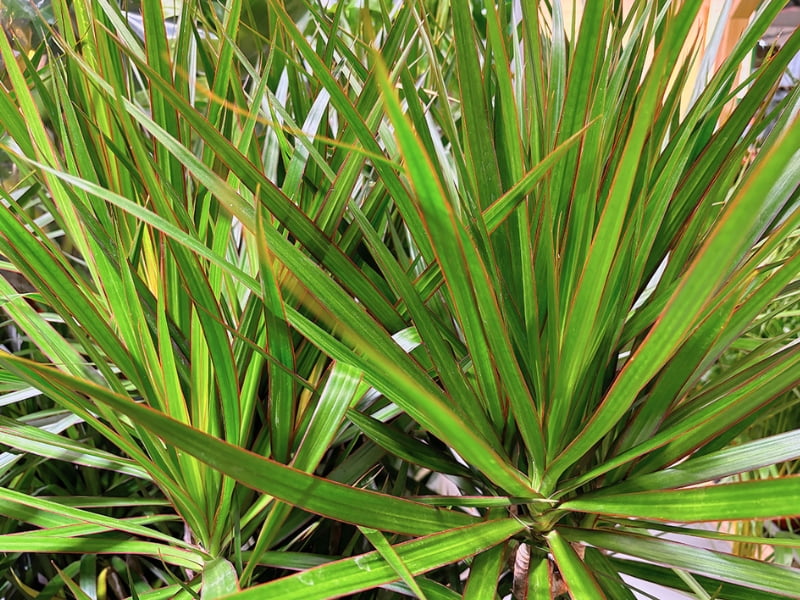Braided Madagascar Dragon Tree, also commonly known as Dracaena marginata, Red-Edged Dracaena, or simply Madagascar Dragon Tree, is a visually striking and resilient houseplant. Its botanical name is Dracaena reflexa var. angustifolia, and it’s prized for its elegantly braided stems and vibrant, sword-shaped leaves.
At Gardencenterpoint.com, we understand the appeal of this unique plant, and this comprehensive guide provides everything you need to know. We’ll cover essential care requirements, troubleshoot common problems, and even guide you toward making an informed purchase. Keep reading to unlock the secrets to a thriving Braided Madagascar Dragon Tree.

What is Braided Madagascar Dragon Tree? Origins and Characteristics
The Braided Madagascar Dragon Tree, despite its name, isn’t a true tree but rather a member of the Asparagaceae family, which also includes plants like asparagus and hostas. It’s native to Madagascar, an island nation off the coast of Africa known for its unique biodiversity. This origin explains the plant’s preference for warm, humid conditions and bright, indirect light, similar to its natural habitat.
| Common name | Braided Madagascar Dragon Tree, Red-Edged Dracaena, Madagascar Dragon Tree |
| Botanical name | Dracaena reflexa var. angustifolia (formerly Dracaena marginata) |
| Family | Asparagaceae |
| Genus | Dracaena |
| Species | reflexa (variety angustifolia) |
| Origin | Madagascar |
| Native | Madagascar |
| Life cycle | Perennial |
| Plant type | Shrub (often grown as a tree-like houseplant) |
| Hardiness zone | 10-12 (USDA) |
| Sunlight | Bright, indirect light |
| Maintenance | Low |
| Water | Low to moderate; allow soil to dry slightly between waterings |
| Drainage | Well-drained |
| Spacing | 1-3 feet (depending on pot size and desired growth) |
| Flowering period | Rarely flowers indoors |
| Height | Up to 6-8 feet indoors (potentially taller) |
| Growth rate | Slow to moderate |
| Leaf color | Green with red or purple margins |
| Stem color | Brown, textured (becoming more pronounced with age) |
| Flower benefit | Not significant for indoor cultivation; primarily grown for foliage |
| Garden style | Suitable for various indoor garden styles; complements modern, minimalist, and tropical themes |
| Uses | Houseplant, container plant, air purifier |
| Toxicity | Mildly toxic to pets if ingested. |
| Soil pH | Slightly acidic to neutral (6.0-7.0) |
| Propagation | Stem cuttings. |
| Humidity | Prefers Moderate to high. |
| Temperature | 65-80F is best. |
| Fertilizer | Every 4-6 weeks during the growing period. |
The “braided” aspect of the plant is not a natural occurrence. It’s a horticultural technique where multiple young, flexible Dragon Tree plants are carefully interwoven as they grow. This creates a visually appealing, sculptural effect that adds to the plant’s overall charm. The braiding process requires patience and skill, and it’s typically done by experienced growers before the plants are sold.
The leaves of the Dracaena marginata are typically narrow, lance-shaped, and have a striking red or purple edge, giving the plant its “Red-Edged Dracaena” moniker. The intensity of the color can vary depending on light exposure; brighter light generally results in more vibrant coloration. The leaves grow in a rosette pattern from the top of the stem, creating a fountain-like appearance.
Over time, the lower leaves will naturally yellow and fall off, revealing the attractive, textured stem. This is a normal part of the plant’s growth cycle and shouldn’t be cause for concern. In fact, it contributes to the plant’s mature, tree-like appearance.
The Madagascar Dragon Tree is a relatively slow-growing plant, especially indoors. This makes it a good choice for those who prefer low-maintenance houseplants. It can, however, reach a significant height over time, potentially up to 6-8 feet or even taller in ideal conditions. Regular pruning can help maintain a desired size and shape.
Beyond its aesthetic appeal, the Madagascar Dragon Tree is also known for its air-purifying qualities. A NASA Clean Air Study demonstrated that Dracaena plants, including Dracaena marginata, can help remove common indoor pollutants like formaldehyde, benzene, and trichloroethylene. These chemicals are often found in household materials like paints, carpets, and cleaning products. While the plant’s air-purifying capabilities shouldn’t be overstated, it’s a welcome added benefit.
Here’s a table summarizing the key characteristics of the Braided Madagascar Dragon Tree:
| Feature | Description |
| Growth Habit | Upright, tree-like (though technically a shrub) |
| Leaf Shape | Narrow, lance-shaped, with red or purple edges |
| Leaf Color | Green with red or purple margins |
| Temperature | Prefers warm temperatures (65-80°F / 18-27°C) |
| Humidity | Moderate to high humidity preferred |
| Propagation | Stem cuttings |
| Air Purification | Removes formaldehyde, benzene, and trichloroethylene (according to NASA Clean Air Study) |
| Toxicity | Mildly toxic to pets if ingested |
| Braiding | The braiding is a man made feature. |
Essential Care for Braided Madagascar Dragon Tree
Providing the right care for your Braided Madagascar Dragon Tree is crucial for its health and longevity. While it’s a relatively low-maintenance plant, understanding its specific needs will help it thrive.
Light Requirements
The Madagascar Dragon Tree thrives in bright, indirect light. This means a location near a window where the plant receives plenty of light, but not direct sunlight. Direct sun can scorch the leaves, causing brown spots and damage. An east-facing window is often ideal, as it provides gentle morning light. South or west-facing windows can also work, but you may need to filter the light with sheer curtains or blinds, especially during the hottest part of the day.
If you’re unsure about the light levels in your home, you can use a light meter to measure the intensity. A reading of 1,000-2,000 lux is generally considered bright, indirect light. Alternatively, you can observe the plant’s behavior. If the leaves are pale or the red edges are fading, it may not be receiving enough light. Conversely, if the leaves are developing brown spots or appear scorched, it may be getting too much direct sun.
In lower light conditions, the plant’s growth will slow down, and the leaves may become less vibrant. While the Dragon Tree can tolerate lower light, it won’t thrive in these conditions. If you don’t have a suitable window, you can supplement with artificial grow lights. Full-spectrum LED grow lights are a good option, as they provide the wavelengths of light that plants need for photosynthesis.
Watering
One of the most common mistakes in caring for Madagascar Dragon Trees is overwatering. These plants are relatively drought-tolerant and prefer to dry out slightly between waterings. Overwatering can lead to root rot, a serious condition that can kill the plant.
The best way to determine when to water is to check the soil moisture. Stick your finger about 1-2 inches into the soil. If it feels dry to the touch, it’s time to water. If it’s still moist, wait a few more days and check again. The frequency of watering will depend on several factors, including the size of the pot, the type of soil, the temperature, and the humidity. In general, you’ll need to water more frequently during the warmer months and less frequently during the cooler months.
When you water, do so thoroughly, allowing the water to drain out of the bottom of the pot. This ensures that the entire root system is hydrated. Discard any excess water that collects in the saucer, as sitting in water can also contribute to root rot.
Using well-draining potting mix is also essential for preventing overwatering. A mix specifically formulated for cacti and succulents, or a general-purpose potting mix amended with perlite or sand, will provide good drainage.
Soil and Potting
The right soil and pot are essential for the health of your Braided Madagascar Dragon Tree. As mentioned above, a well-draining potting mix is crucial. A mixture of peat moss, perlite, and vermiculite is a good option. You can also use a pre-mixed cactus and succulent potting mix. Avoid using heavy garden soil, as it can retain too much moisture and lead to root rot.
The pot should have drainage holes to allow excess water to escape. Choose a pot that is slightly larger than the plant’s root ball. A pot that is too large can hold too much moisture, while a pot that is too small can restrict root growth. Terracotta pots are a good option, as they are porous and allow for better airflow to the roots.
Repotting is generally only necessary every 2-3 years, or when the plant becomes root-bound. Signs that your plant is root-bound include roots growing out of the drainage holes, water running straight through the pot without being absorbed, and slow growth. When repotting, choose a pot that is only one size larger than the previous pot. Gently remove the plant from its old pot, loosen any circling roots, and place it in the new pot with fresh potting mix. Water thoroughly after repotting.
Temperature and Humidity
The Madagascar Dragon Tree prefers warm temperatures and moderate to high humidity, reflecting its tropical origins. The ideal temperature range is 65-80°F (18-27°C). It can tolerate slightly cooler temperatures, but prolonged exposure to temperatures below 55°F (13°C) can damage the plant. Avoid placing the plant near drafts from air conditioners or heating vents, as these can cause temperature fluctuations.
Humidity is also important for the Dragon Tree’s health. Low humidity can cause the leaf tips to turn brown and crispy. To increase humidity, you can use a humidifier, place the pot on a tray filled with pebbles and water (making sure the pot is not sitting directly in the water), or group plants together. Misting the leaves regularly can also help, but it’s not as effective as other methods.
Fertilizing
While the Madagascar Dragon Tree is not a heavy feeder, it does benefit from occasional fertilization, especially during the growing season (spring and summer). Use a balanced, water-soluble fertilizer diluted to half strength. Apply the fertilizer every 4-6 weeks during the growing season. Avoid fertilizing during the fall and winter, when the plant’s growth slows down.
Over-fertilizing can also be harmful, leading to salt buildup in the soil and potentially burning the roots. If you notice a white crust forming on the surface of the soil, it’s a sign of over-fertilization. Flush the soil with plenty of water to remove the excess salts.
Pruning
Pruning is not strictly necessary for the Madagascar Dragon Tree, but it can be helpful for maintaining its shape and size. You can prune to remove any yellowing or damaged leaves, or to control the plant’s height.
To prune, use clean, sharp pruning shears or scissors. Make cuts at a slight angle, just above a leaf node (the point where a leaf attaches to the stem). Avoid cutting into the braided portion of the stem, as this can damage the plant.
Pruning can also encourage bushier growth. If you want to promote branching, you can prune the top of the main stem. This will stimulate the growth of new shoots from the sides.

Troubleshooting Common Problems
Even with the best care, you may encounter some problems with your Braided Madagascar Dragon Tree. Identifying the issue early and taking appropriate action can prevent more serious problems.
Brown Leaf Tips:
Brown leaf tips are a common problem, often caused by:
- Low Humidity: As mentioned earlier, dry air can cause the leaf tips to turn brown and crispy. Increase humidity around the plant.
- Underwatering: While overwatering is a more serious problem, underwatering can also lead to brown leaf tips. Check the soil moisture regularly and water when the top inch or two is dry.
- Fluoride or Chlorine in Tap Water: Some plants are sensitive to the chemicals in tap water. Use filtered water or let tap water sit out for 24 hours before watering to allow the chlorine to dissipate.
- Salt Buildup from Fertilizer: Over-fertilizing can lead to salt buildup, which can burn the leaf tips. Flush the soil with water to remove excess salts.
Yellowing Leaves:
Yellowing leaves can indicate several issues:
- Overwatering: This is the most common cause of yellowing leaves. Check the soil moisture and adjust your watering schedule accordingly.
- Poor Drainage: Make sure the pot has drainage holes and that the soil is well-draining.
- Nutrient Deficiency: Yellowing leaves can be a sign of a lack of nutrients, particularly nitrogen. Fertilize with a balanced fertilizer during the growing season.
- Natural Aging: As the plant ages, the lower leaves will naturally yellow and fall off. This is normal and not a cause for concern.
Brown Spots on Leaves:
Brown spots on the leaves can be caused by:
- Direct Sunlight: Direct sun can scorch the leaves, causing brown spots. Move the plant to a location with bright, indirect light.
- Fungal Diseases: Fungal diseases can also cause brown spots. Improve air circulation around the plant and avoid overwatering. You may need to use a fungicide if the problem is severe.
- Pests: Examine carefully.
Pests:
The Madagascar Dragon Tree is relatively pest-resistant, but it can occasionally be affected by:
- Mealybugs: These are small, white, cottony insects that suck sap from the plant. They often hide in the crevices between leaves and stems.
- Spider Mites: These are tiny, spider-like pests that create webs on the undersides of leaves. They also suck sap from the plant, causing yellowing and stippling.
- Scale: These are small, brown, immobile insects that attach themselves to the stems and leaves.
To control pests, you can try the following:
- Inspect Regularly: Check your plant regularly for signs of pests.
- Wipe with Alcohol: For small infestations, you can wipe the pests off with a cotton swab dipped in rubbing alcohol.
- Insecticidal Soap: For larger infestations, you can use an insecticidal soap spray. Be sure to follow the instructions on the label.
- Neem Oil: Neem oil is another effective treatment for many pests.
How to Braid a Madagascar Dragon Tree
Braiding a Madagascar Dragon Tree is a horticultural technique that requires patience and skill. It’s typically done by experienced growers, but with careful practice, you can try it yourself.
Materials Needed:
- Young Madagascar Dragon Tree Plants (3 or more): Choose plants that are young, flexible, and of similar height.
- Potting Mix: Well-draining potting mix, as described earlier.
- Pot: A pot with drainage holes, large enough to accommodate all the plants.
- Plant Ties or Soft Twine: To secure the braids.
- Gloves
Step-by-Step Instructions:
- Prepare the Plants: Gently remove the young Dragon Tree plants from their individual pots, being careful not to damage the roots.
- Position the Plants: Arrange the plants in a circle in the new pot, spacing them evenly. The stems should be close together.
- Begin Braiding: Start with three plants. Take the right-hand stem and cross it over the middle stem. Then, take the left-hand stem and cross it over the new middle stem (which was originally the right-hand stem).
- Continue Braiding: Continue this pattern, always crossing the right stem over the middle, then the left stem over the middle. Keep the braid relatively loose at first.
- Secure the Braid: Once you’ve braided a few inches, use a plant tie or soft twine to gently secure the braid. This will help hold the stems in place as they grow.
- Continue Braiding and Securing: Continue braiding and securing the stems as they grow. You may need to add new ties as the braid gets longer.
- Adjust the Braid: As the plants grow, you can gently tighten the braid to create a more defined look. Be careful not to over-tighten, as this can damage the stems.
- Potting: Fill the pot with the prepared potting mix, ensuring the base of the stems are covered.
- Watering: Water the newly planted and braided trees.
Important Considerations:
- Patience: Braiding takes time and patience. The plants need to grow and adapt to their new shape.
- Gentle Handling: Be gentle when handling the stems to avoid breaking them.
- Regular Adjustments: As the plants grow, you’ll need to regularly adjust the ties and the braid to maintain the desired shape.
- Not Permanent: The braiding is not permanent. Over time, as the stems thicken, the braid may become less defined.

Braided Madagascar Dragon Tree Uses and Benefits
The Braided Madagascar Dragon Tree offers more than just a striking visual presence; it provides a range of benefits that make it a valuable addition to any indoor space. From its aesthetic versatility to its air-purifying capabilities and ease of care, this plant is a popular choice for both novice and experienced plant enthusiasts.
One of the primary uses of the Braided Madagascar Dragon Tree is as an ornamental houseplant. Its unique braided stems and vibrant, arching foliage add a touch of elegance and tropical flair to any room. It can serve as a focal point in a living room, a calming presence in a bedroom, or a welcoming accent in an entryway. The plant’s vertical growth habit makes it particularly well-suited for spaces with limited floor space, as it draws the eye upward and creates a sense of height.
The versatility of the Braided Madagascar Dragon Tree extends to its compatibility with various interior design styles. Its sleek, modern appearance complements contemporary and minimalist decor, while its natural texture and vibrant color also blend seamlessly with bohemian, eclectic, or even traditional settings. It can be placed in a decorative pot to match your existing decor, further enhancing its visual appeal.
Beyond its purely aesthetic qualities, the Braided Madagascar Dragon Tree offers tangible benefits for indoor air quality. As highlighted in the NASA Clean Air Study, Dracaena species, including Dracaena reflexa var. angustifolia, are effective at removing certain airborne pollutants from indoor environments. These pollutants, such as formaldehyde, benzene, and trichloroethylene, are commonly emitted by household materials like paints, furniture, carpets, and cleaning products. While the plant’s air-purifying abilities shouldn’t be considered a complete solution to indoor air pollution, it’s a contributing factor to a healthier indoor environment.
The ease of care associated with the Braided Madagascar Dragon Tree is another significant benefit. This plant is relatively low-maintenance, making it an excellent choice for individuals with busy lifestyles or those who are new to plant care. Its tolerance for infrequent watering and its adaptability to a range of light conditions contribute to its resilience. This doesn’t mean it’s entirely neglect-proof, of course; following the basic care guidelines outlined earlier in this guide will ensure its continued health and vibrancy.
For those seeking a plant with a unique visual appeal and air-purification, without a high time investment, the Dragon Tree is perfect. The plant helps reduce several airborne pollutants as well as carbon dioxide.
The Braided Madagascar Dragon Tree also offers a sense of tranquility and connection to nature. Studies have shown that indoor plants can reduce stress levels, improve mood, and boost productivity. The presence of greenery in a home or office can create a more calming and inviting atmosphere. The simple act of caring for a plant can also be a therapeutic and rewarding experience.
In some cultures, Dracaena plants are associated with good luck and prosperity. While these beliefs are not scientifically proven, they add to the plant’s overall appeal and make it a thoughtful gift for housewarmings, new businesses, or other special occasions.
Here’s a summary table of the uses and benefits:
| Use/Benefit | Description |
| Ornamental Houseplant | Adds visual appeal, elegance, and a tropical touch to indoor spaces. |
| Versatile Decor | Complements various interior design styles, from contemporary to bohemian. |
| Air Purification | Helps remove common indoor pollutants like formaldehyde, benzene, and trichloroethylene (according to NASA Clean Air Study). |
| Low Maintenance | Easy to care for, requiring infrequent watering and adapting to a range of light conditions. |
| Stress Reduction | Indoor plants can reduce stress, improve mood, and boost productivity. |
| Symbol of Good Luck | In some cultures, Dracaena plants are associated with good luck and prosperity. |
| Therapeutic Activity | Caring for plants. |
Gardencenterpoint.com recommends considering the Braided Madagascar Dragon Tree not just as a decorative element, but as a holistic addition to your indoor environment, contributing to both aesthetic appeal and overall well-being.
Purchasing a Braided Madagascar Dragon Tree
If you’re not ready to tackle the braiding process yourself, you can purchase a pre-braided Madagascar Dragon Tree.
What to Look for When Buying:
- Healthy Foliage: Look for a plant with vibrant green leaves and no signs of yellowing, browning, or pests.
- Strong Stems: The stems should be firm and not easily bent or broken.
- Well-Defined Braid: The braid should be neat and even, without any loose or damaged stems.
- Proper Potting: Make sure the plant is potted in a well-draining potting mix and a pot with drainage holes.
- Price: Expect to pay anywhere from $20- 100 depending on the nursery and size.
Where to Buy:
- Local Nurseries and Garden Centers: These are often the best places to find healthy, well-cared-for plants. Gardencenterpoint.com can help you locate reputable nurseries in your area.
- Online Retailers: Many online retailers sell Braided Madagascar Dragon Trees. Be sure to read reviews and choose a reputable seller. Gardencenterpoint.com provides links to trusted online sources.

Leave a Reply